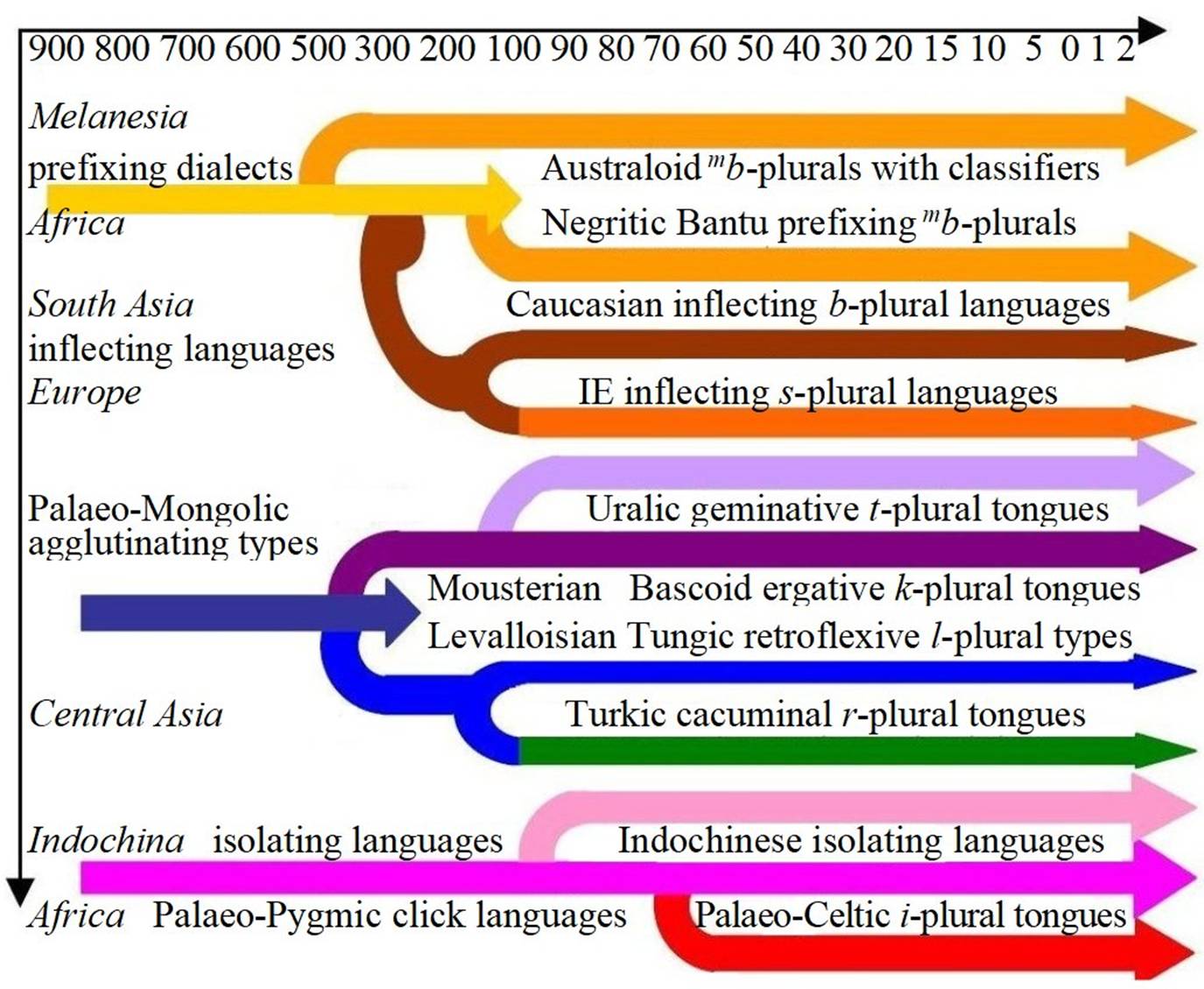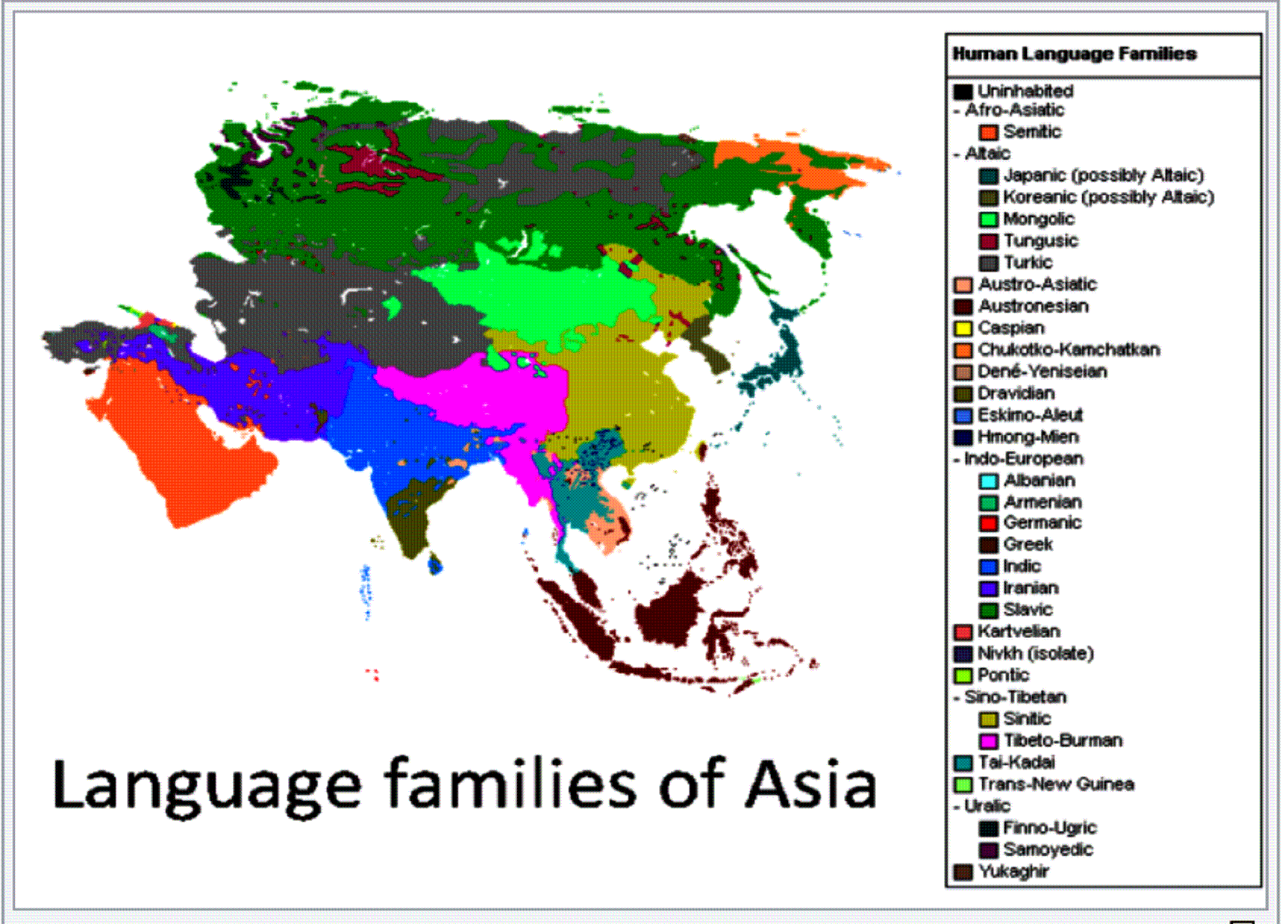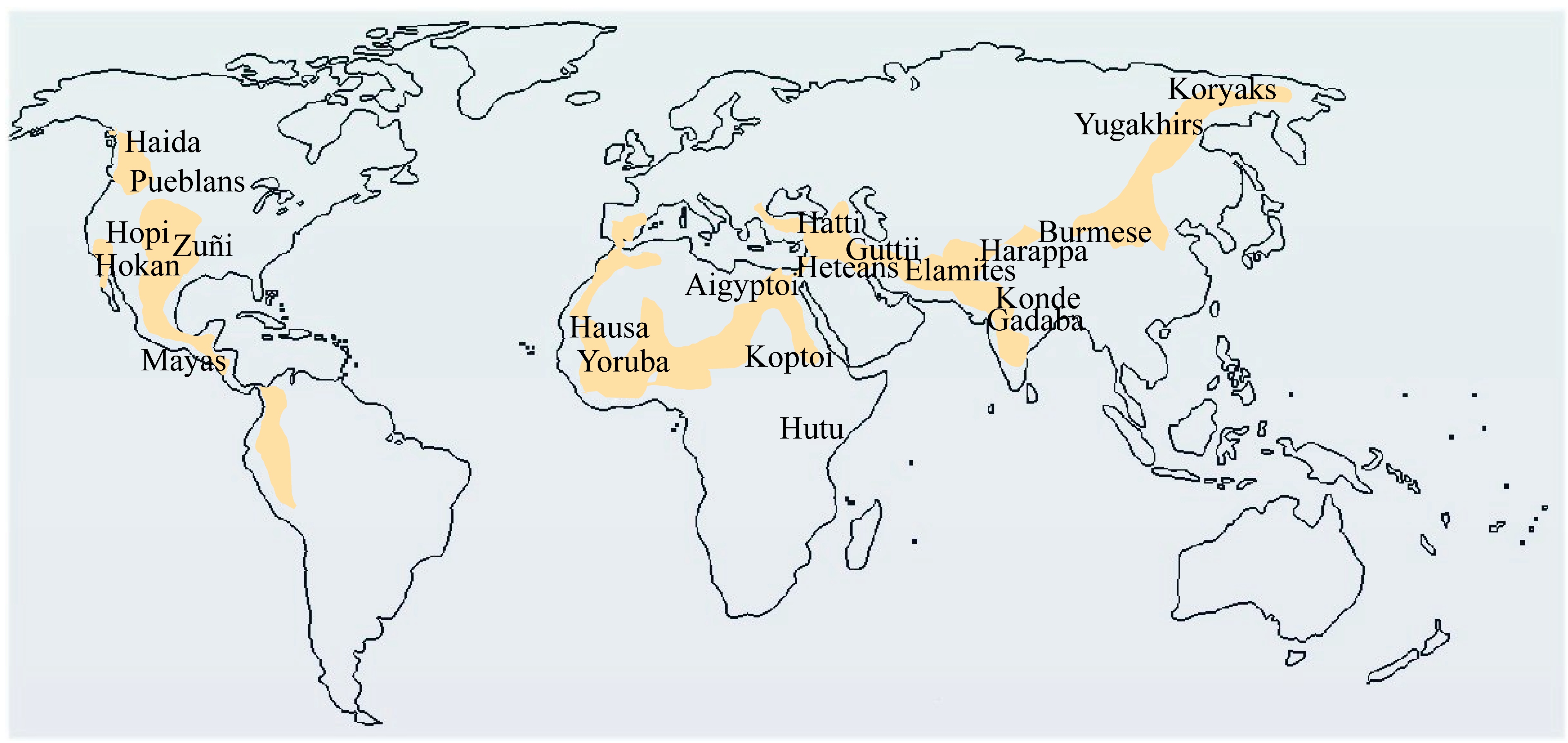|
|
|
|||||||||||||||
|
|
|
|||||||||||||||
|
|
|
|
||||||||||||||
|
|
|
|
||||||||||||||
|
|
|
|
||||||||||||||
|
|
|
|||||||||||||||
|
|
|
|
|
|||||||||||||
|
|
The Earliest Ancestors of Acheulean, Yabrudian,
Caucasian and Elamite Languages Clickable terms are red on the yellow background |
|
||||||||||||||
|
Table 1. The Systematic Glottogenesis of Human
Language Families |
||||||||||||||||||||||||||||||||||||||||||||||||||||||||||||||||||||||||||||||||||||||||||||||||||||||||||||||||||||||||||||||||||||||||||||||||||
|
Map 1.
The Distribution of Ancient
Asiatic Language Families
Table 2. Renaming
Asiatic Language Families |
||||||||||||||||||||||||||||||||||||||||||||||||||||||||||||||||||||||||||||||||||||||||||||||||||||||||||||||||||||||||||||||||||||||||||||||||||
|
Map 2. The Distribution of Caucasoid
and Elamitoid Languages with b-plurals and Ergative Constructions |
||||||||||||||||||||||||||||||||||||||||||||||||||||||||||||||||||||||||||||||||||||||||||||||||||||||||||||||||||||||||||||||||||||||||||||||||||
The Elamite and Caucasoid Family of Languages
The problem of Caucasian proto-language and Indo-European is
solved by focusing on avalanches of ephemeral sound shifts instead of
considering genetic stability and structural typology. The white Caucasoid
race is an outgrowth of macrolithic hand-axe populations of tall
dolichocephals with vegetal subsistence and (pre)agricultural dispositions,
and its development competed with the Altaic races with flake-tool cultures.
These cultural traditions did not differentiate by unilinear monogenesis from
a common prehistoric unity but pursued independent growth by paragenesis in
several interfertile and interbreedable racial lineages. Their
archetypal differences were manifested by absolutely incompatible phonologies
and grammatical systems. African Negrids, Asiatic Caucasoids and European
Nordids applied cordal languages, whose consonantism was based on the
vibration of vocal cords and the opposition of voiced and surd phonemes
(Table 3). They pronounced vocalic cordal phonemes based on open syllables
and phonemes produced by airstream passing through vibrating vocal cords. If
there were any structural changes, they were caused by mixing with Altaic
agglutinating systems.
Table 3. The cordal
phonology of dolichocephals with macrolithic hand-axe industry Table 3 demonstrates an organic growth of
IE phonology from the Ursprache of Elamitoid Caucasoids and its
incompatibility with Germanic innovations hiding away Turanid origins. Table
4 attempts to reconstruct the steps that led to transformations of the earliest
Oldowan languages into Acheulean structure in grammar. It was a process of
changing Bantu language paradigms into the Caucasoid morphology and syntax.
It resulted from their clash with Asiatic flake-tool cultures with
agglutinating morphology. It implied turning African prefixing morphemes into
Asiatic suffixing constructions and reduced Bantu nominal classifiers to the
gender opposition of animate and inanimate nouns. Another result was the rise
of ergative constructions inherited from Tabunian Proto-Mousterians (Homo
heidelbergensis) settled in the Levant or the Arabian Peninsula. Elementary grammatical systems fall into
three types of nominal and verbal morphology. The gender-oriented morphology
is attributable to the language family of tall dolichocephals with hand-axe
industry and vegetal subsistence. In its original appearance documented in
African, Melanesian and Australian Negrids it partitioned nouns into classes
of animate, inanimate, vegetal and arboreal classes. These classed were
distinguished by prefixes put in front of nouns. In the Horn of Africa their
family ran upon Asiatic races with agglutinating language structures and
transitioned to suffixing morphology of inflecting type. The group of Asiatic
plant-gatherers, hoe-cultivators and agriculturalists reduced the system of
twelve nominal classifiers to the opposition of animate and inanimate nouns.
Their category included humans, animals, animistic spirits as well as sacral
deities.
Table 4. The nominal
morphology of dolichocephals with macrolithic hand-axe industry The chief representatives of Acheulean
languages were found in Anatolia, the Near East and Mideast. Their traces in
Asia Minor, Judea and Mesoponamia underwent assimilation, so their best
records have been preserved only in Georgian, Mingrelian, Persian and Burmese
languages. Another groups of survivals may be sought in Middle and New
Egyptian with w-plurals and in Ethiopian dialects. Their fates are
difficult to reconstruct but we may presuppose that there existed a strong
parallelism of development between Avestan and Sanskrit. Both dialectal
traditions were exposed to similar partners and absorbed their influences in
phonology as well as morphology. The categorisation in
Tables 3, 4 survived also in Anatolian tongues until their further expansion
in the Balkans encountered Gravettian tribes of Alpinids with sex-based
gender classifications. Their clash resulted in the rise of sex-based nominal
gender enriched by masculine o-stems and feminine a-stems. The
core of European languages accepted the dual opposition of masculine and
feminine gender. Yet some Iranian languages remained reluctant to their
addition and continued to adhere to nominal i-stems. Their subclasses
coexisted with Caucasoid vegetal u/w-stems that can be
explained as remains of Caucasoid b-plurals referring to agricultural crops
and instruments of farming activities. The classification of Indo-European
thematic and athematic stems may be regarded as a hold-over of ancient
invasions and infiltrations surviving in residual form in the territory of
Europe. The sex-based gender distinction of the suffixes -o and -a
first appeared in African Chadic and Ethiopian Galla languages and their
spread all over Europe was due to the Gravettian colonisation of short-sized
brachycephals to the north. They were embedded into the system of IE accidence
as new thematic stems distinguishing the masculine o-stems and
feminine a-stems. The u-stems penetrated into the IE word stock
with the propagation of Neolithic farming from the Fertile Crescent to the
Danubian river basin.
Table 5. Conservative
embeddings and regressive intrusions in Old Persian consonantism The first autochthons in
India were Negrids, whose word stock with prenasalised stops was absorbed
into Sanskrit by adding the prothetic vowel a-. As a result, the
initial phonemes /mb- nd- ŋg-/ were encapsulated into its norm as amb-, and- and ang-. After the arrival of black-skinned Negrids of Oldowan origin there
appeared a colonisation of Acheulean hand-axe cultures (800,000 BP) that
discarded prenasalisation and replaced the prefixing ba-plurals of
human beings with suffixal b-plurals as in Dravidian Gadaba and Gutob
in North Indian Punjab. In dialects of Central Asia they accompanied the
ethnonyms of Caspii and Lullubi. The first Indo-European
newcomers were Campignian Littoralists (10,000 BC) with cordmarked pottery,
who colonized the Vindhya Range in Gujarat. They were not populous enough to
Europeanise the entire Indian subcontinent but they disposed of an advanced
educated religious tradition that enabled their Brahman descendants to get
hold of an enviable scriptural monopoly. They managed to reinforce it as an
official administrative standard used in religious rites. Their integration
involved embedding the Brahmanic Proto-Gothic voiced plosives b, d,
g into the local phonological framework with murmured breathed stops bh-, dh-, gh-. Their heritage may be ascribed to Acheuloid racial groups with
Y-haplogroups G and H, whose occurrence culminates in the Indian
subcontinent. The Dravidian element in Old
Indian was represented by retroflex consonants written as ṭ, ḍ,
ṇ, ṣ, ẓ, ḷ, ɾ̣,
ɹ̣ but the IPA standard records them as /ʈ, ɖ , ɳ, ʂ, ʐ, ɭ, ɻ, ɽ/. They were notable for pronunciation with the tip of the tongue bent
backwards in a concave or curled shape. Their use was
obliterated in most language families but their remains often survive in the
affricates tr- dr-, tl- and dl-.
Most types of notation do not distinguish their apical and laminal
pronunciation. The laminal retroflex consonants were characteristic of
Tungusoid fishermen, who disseminated them in Eurasia with Aurignacian
colonisations around 40,000 BP. The apical or cacuminal retroflex consonants
must have been imported by Turcoid cultures with microlithic flake-tools
around 11,000 BC. These ethnic factions influenced also Iranian and Caucasian
languages but in less visible measure. (from Pavel Bělíček: The
Analytic Survey of European Anthropology, Prague 2018, pp. 35-41) |
The Elamite and Caucasoid Languages with b-plurals Caucasoid languages do not
differ from Palaeo-Negroid languages only in age and dating, their principal
difference was one between a mixed heterogeneous system and a pure archetype.
They developed a new linguistic type of inflecting declensions and
conjugations because their grammatical morphemes lost their original
regularity and structural clarity by assimilation. Their inflecting paradigms
were hybrid structures mixed from Palaeo-Negroid prefixing languages and
Palaeo-Mongoloid suffixing agglutination. Some of their morphemes resulted
from transforming prefixes into suffixes and some were agglutinating suffixes
adopted from their northern neighbours. The inner Negroid substance was
preserved transparent as a substratum in the shape of a Mongoloid environment
in order to give birth to Caucasian and Indo-European irregular inflection.
This result of their symbiosis was as inorganic as is the white Caucasoid and
Nordic race. Both are two incongruous mixtures of black, yellow and dwarfish
people in different mutual rates. In spite of their secondary derived origin,
they formed compact contact unities owing to a long-term common
existence. In North Africa the element
of Palaeo-Negroid peasants and their prefixing classifiers is still dominant
but in the Near East and the Caucasus it was rather suppressed by Hamitoid
pastoralists and condemned’ to a subdominant position. Originally,
Palaeo-Negroids formed a continuous belt of plant-gathering populations
leading from the tropical forests of Africa to the tropical forests of
Austronesia. Later one stretch of this belt, centred in the Near East, formed
a bridge exposed to a long-term linguistic influence of Turkic, Uralic and
Altaic languages. As a result, there appeared a number of Hamitic, Semitic
and Caucasian dialects with different rates of their phonemic, grammatical
and lexical patterns. The most characteristic survival is a group of Lezghian
languages (Budukh, Botlix, Dargin, Godoberi) that have surprisingly preserved
Palaeo-Negroid phonemes, prefixing affixation, classifiers as well as subject
and object markers. This deep layer of Proto-Caucasian was
superimposed by Acheulian and Micoquian newcomers who started their travels
in North Africa and spread a new reformed standard as far as India, the Far
East and America. Caucasoid tribes remained inactive during the last Wurm
glaciation and were restored to life about 10,000 BC when they set out
as Basket-Makers to conquer America. Now it is amazing to compare Lezghian
languages as an archaic Eteo-Negroid survival with Georgian and Kartvelian
dialects that represent the reformed Caucasoid standard. Comparative linguistics
tends to subsume Caucasoid languages chiefly into two large families. The
first group are Semito-Hamitic languages (Cohen 1947; Diakonoff 1965)
that were renamed as Afroasiatic family thanks to the theoretical
initiative of J. H. Greenberg (1958, 1963a). The second group consists of a
few independent families in the Caucasus that A. Dirr (1928) called Caucasian
languages but Russian philology insists on applying the term of
‘Ibero-Caucasian languages’. These are divided into Kartvelian,
Abkhazo-Adygean, Dagestani and Nakh families (Deshiriyev 1978: 90) or into
Kartvelian, Abkhazo-Adygean, Avar-Andi-Cez, Lezghian, Dargino-Lak and
Bats-Chechen group (Jazyki narodov SSSR IV, 1967). The Kartvelian (Georgian, Mingrelian, Zan, Svan) and Abkhaz group
(Adygei, Abazin, Kabardin) are mostly found in Georgia, the Nakh group (Bats,
Ingush, Chechcn) and Dagestani languages are concentrated in the east
Caucasus. Such classifications of
Caucasian languages suffer much from imprecision because it is not based on
‘genetic kinship’ but on real grouping and ‘secondary contact unities’
(Palmaitis 1978). Two layers of their common dominant superstratum, which
cannot be mistaken for a common predecessor, are formed by b-languages
remarkable for the plural marker -b. Other subfamilies could be
classified as overlapping with Turkic, Bulgarian, Ossetic and Scythian
families and denoted as something like Turco-Caucasian. Instead of
introducing new tedious terms we had better use convenient working coinage
such r-Caucasian as an informal concept for all
Caucasian languages containing statistically relevant rates of Turcoid r-plurals.
Proto-Caucasian: Godoberi, Tindi, Bagvali, Dargin, Tsaxur, Bezhita,
Rutul, b-Caucasian: Georgian, Mingrelian, Lazi, Svan, Ginux, Gunzib, Xvarshi, r-Caucasian: Agul, Rutul, Tsaxur, Archi, Budux, Xinalug, Kryz l-Caucasian: Svan, Avar, Andi, Botlix, Axvax, Bezhita, Caucasoid b-languages
in Nigeria, Chad and Sudan cannot be divided into areal groups, either. Their
westernmost belt starts with the Fula or Western Atlantic subgroup
(Wolof, Serer, Fula), Hausa group (Hausa, Yoruba, Kotoko) and a Chadic
subfamily (Bolewa, Kotoko). The Coptic group includes (Middle Coptic,
Middle Egyptian) and some Cushitic languages (Sidomo, Iraqw). In the Near
East their stock was represented by Elamite that stands for related
dead languages of Kaspii, Gutii and Lullubei. In the
Caucasus their belt continued with b-Caucasian languages. Further travels
continued to the east and settled down in Tokharian remarkable for the plural
ending -wa (Poboźńiak 1985: 258.). Since the tongues of Harappa
civilisation have not been deciphered satisfactorily, their progeny must be
sought in most Indian and some Dravidian languages. In southern India the peasant
substratum with b-plurals is represented by the Kodagu subgroup
of Dravidians (Khonde, Kota, Kolami, Kodagu and Gadaba). Nobody can prove
that they are Acheulian autochthons who as far as the Movius Line in eastern
India where their eastward travels stopped (Feder, Park 1997: 255). More active that this
isolated archaic settlement was the group of Basket-Makers that
penetrated to the Amur and the Far East about 8,000 BC. The family of Palaeo-Siberian
languages with b-plurals includes Youkaghir, Aleutian and Koryak,
other kinsmen of this stock probably became extinct amidst the Ural-Altaic
element. The plurals in -vlak in Mari may document one isolated islet
and one possible travel route across Siberia. After passing the Bering Strait
basket-makers proceeded southward to the fertile lowland plains in the
southeast of North America but their mainstream headed for Mexico. The Siouan, Caddoan and Mayan families had
probably their starting-po Turkmenistan. The Tupí-Guaraní group, on the other
hand, seems to grow out from more ancient roots of Austronesian stamp. The Caucasoid Declension
Inflecting languages are considered as one of independent
linguistics types common in the European and Caucasian area (Skalička 1951;
Miłewski 1948). Typical inflecting systems may be studied in the
Indo-European family and the Kartvelian group. Inflection resembles
agglutination safe for a lack of clear etymology and structural regularity.
Whereas Ural-Altaic agglutinating suffixes may be joined arbitrarily and cumulated
mechanically to one another, every Indo-European and Caucasian inflecting
marker is a unique complex indecomposable unit without clear etymology. Owing
to a strong tendency to fuse morphemes into irreducible units, inflecting and
‘flectional’ languages are also classified as fusional, ‘amalgamating’
or ‘assimilating’ language structures (Axmatova 1966: 532, Erhart 1984).
The most remarkable manifestation of inflection are Indo-European
declensions considered as system of case paradigms divided according to
different stems, numbers and gender categories. The Caucasoid inflection may
be represented by Elamite that that has two gender categories (genus
personale for animate beings and genus materiale for inanimate
things). There are two numbers, singular and plural, no evidence of
duals was indicated. Singulars of animate nouns end in -k, their
plurals are remarkable for the ending -p that corresponds to the markers ua-,
ui- and pi- in Hattic. Inaminate nouns have a singular marker -r
and a plural ending -me which is often dropped. This state of nominal
categories is compatible with Hattic, Luvian and Hittite that display the
opposition of animate gender and genus commune for inanimate abstract
and material entities (Labat 1947, McAlpin 1974).
Less typical is the state in Hurrian, Urartean and Georgian. These
languages are Caucasoid in lexical substance but they lack nominal gender and
their case paradigms exhibit more agglutination than pure inflection (Klimov
1979: 115). The Geogian plural marker -eb, Elamite animate plurals in
-p and Hattic ua- and Aramaic -w demonstrate how the
Bantu animate plural prefix b/ba- turned into the Caucasian animate
suffix -p/b. Under the influence of the suffixing Asiatic languages
Caucasoid dialects abandoned prefixing morphology and shifted the
classificatory prefixes to the end of the word. The original prefixed plural
markers were preserved in Hattic pi-, Gunzib b- or Hokan ba-.
In other languages they were shifted to the word-final position and appended
to the root as inflecting suffixes.
On the Caucasian crossroad of prehistoric civilisations the
Palaeo-Negroid nominative construction clashed with the Palaeo-Mongoloid
accusative construction to give birth to the Caucasian ergative
construction. Caucasoid morphology developed from Palaeo-Negroid
classifiers by several fundamental overturns. The most important step
consisted in abandoning Palaeo-Negroid object markers and verbal infixes that
were replaced by case endings attached to nouns. Caucasian case systems and
European declensions originated by dissociating verbal affixes from verbs and
attaching them to nouns in objects following the verb. So the Bantu causative
verbal infix -s- probably turned into the ergative case s-ending
in Caucasoid languages and the Bantu plural marker b- became the
ending of the Caucasian absolutive case. In European languages, where the accusative
construction won owing to Mesolithic hunters of Asiatic origin, this
transformation proceeded in a different way. The Negroid causative infix -s-
became the ending of plural nominatives and the marker -b- began to
refer to plural datives.
There were several groups of languages involved in the ‘ergative
revolution’. Ergativity became very common in the Hamitic, Abxaz and Scythian
family of megalithic cultures though their southernmost archaic promontories
in South Africa (Hottentot Nama, Masai) have an accusative construction.
These pastoralist cultures were intertwined with colonies Caucasian peasants
who acquired the ergative construction by copying Hamitic syntax.
Indo-European languages either escaped ergative constructions or disentangled
their remains by adapting them to Asiatic accusative syntax (Schmalstieg
1980, 1985). (from Pavel Bělíček: Prehistoric Dialects I, Prague 20014, pp. 206-208, 219-220) |
|||||||||||||||||||||||||||||||||||||||||||||||||||||||||||||||||||||||||||||||||||||||||||||||||||||||||||||||||||||||||||||||||||||||||||||||||



